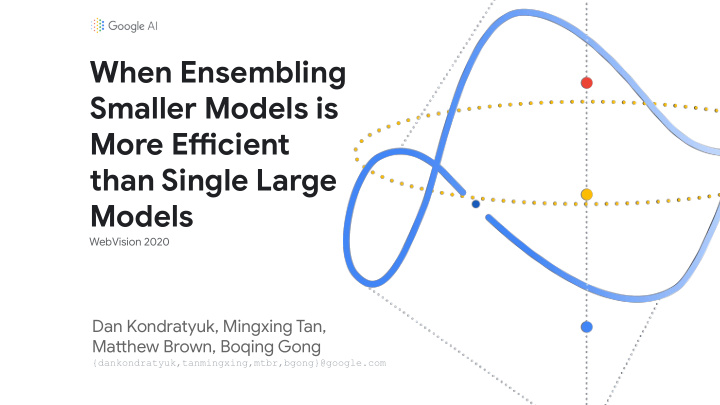



When Ensembling Smaller Models is More Effjcient than Single Large Models WebVision 2020 Dan Kondratyuk, Mingxing Tan, Matuhew Brown, Boqing Gong {dankondratyuk,tanmingxing,mtbr,bgong}@google.com
Model Ensembles Train multiple models and average their predictions during inference ● E.g., train a neural network architecture with difgerent random initializations ○ Easy method to reduce prediction error ● Introduces heavy effjciency penalties ● Prediction Most commonly reserved for the largest models ○ Can small ensembles be effjcient ? ● Aggregation ... Model Model Model 1 2 N Input Example
Image Classifjcation - Wide ResNet - CIFAR 10 Ensembles can be both ● more accurate and more effjcient Each line represents one ○ model architecture Each point indicates the ○ number of models ensembled As model sizes get larger, ○ the pergormance gap widens Larger ensembles produce ○ diminishing returns and become less effjcient
Image Classifjcation - EffjcientNet - ImageNet This trend appears for ● highly optimized models on larger datasets as well EffjcientNet scales the ○ width, depth, and resolution of each model size
NAS Ensemble - ImageNet Can we use NAS to ● generate diverse ensemble architectures? Can architecture diversity ○ boost the accuracy to FLOPs/latency ratio? Pareto curve shown for model ○ ensembles searched with NAS Surprisingly, a single searched ○ model pergorms nearly the same as a diverse ensemble Latency (ms)
Conclusion Ensembles of smaller models can be more accurate and more effjcient ● than single large models, especially as model size grows One can use ensembles as a more fmexible trade-ofg between a model’s inference ○ speed and accuracy Ensembles can be easily distributed across multiple workers, furuher increasing ○ effjciency A single searched model using NAS can fjnd a well-optimized architecture ● for ensembling However, ensembling diverse architectures from a search on multiple models pergorms ○ nearly the same as ensembling one model architecture from the search
Recommend
More recommend